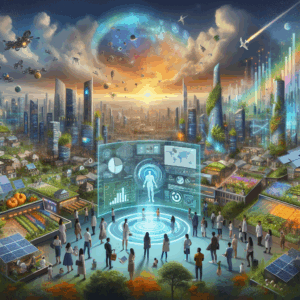The Impact of AI-Driven Technology on Society
Artificial Intelligence (AI) has rapidly evolved from a niche field to a cornerstone of modern technology, weaving its way into the fabric of society and transforming how we operate across various sectors. This post explores AI-driven technology’s profound impact, its notable benefits, accompanying challenges, and the anticipated future developments that could reshape societal landscapes.
Introduction
In recent years, AI-driven technology has gained increasing prevalence, influencing sectors as diverse as healthcare, finance, transportation, and beyond. This transformative technology not only enhances operational efficiency but also introduces new paradigms in decision-making and innovation. Understanding AI’s impact across these sectors is crucial for anticipating future societal changes and addressing the challenges that come with this technological evolution.
In the following sections, we delve into the sectors most affected by AI, the societal benefits and challenges it brings, the role of government in AI deployment, future developments, and offer a technical glance at AI implementation.
Sectoral Impacts of AI
AI’s influence extends across numerous industries, each experiencing unique transformations due to AI integration.
Healthcare
In healthcare, AI-enabled technologies such as telemedicine, electronic health records, and AI diagnostics are revolutionizing patient care. Telemedicine allows remote diagnosis and treatment, thereby improving accessibility and patient outcomes. AI algorithms assist in predicting patient symptoms, optimizing treatment plans, and enhancing operational efficiency by automating administrative tasks.
Transportation
The transportation sector benefits from AI through autonomous vehicles and smart traffic management systems. AI solutions reduce human error, optimize fuel efficiency, and enhance safety with real-time traffic data analytics. Automated public transportation systems, championed by initiatives like the U.S. Department of Transportation, further exemplify AI’s crucial role in infrastructure management.
Finance
In finance, AI is redefining risk assessment, fraud detection, and personalized customer service. Machine learning models evaluate credit risks with greater accuracy, while AI-driven bots offer tailored customer interactions and real-time financial advice.
Workforce Changes
While AI increases productivity, it also raises concerns about workforce changes and potential job displacement. Automation of routine tasks may render certain job roles obsolete, necessitating upskilling and education reform to prepare the workforce for AI-centric careers.
Benefits of AI Technology
Enhanced Efficiency
AI significantly boosts productivity and operational efficiency by automating manual processes. It streamlines complex operations, allowing industries to allocate resources toward strategic activities.
Improved Decision-Making
With AI’s ability to process vast amounts of data, industries gain enhanced insights, leading to informed decision-making. Data-driven strategies empower businesses to respond swiftly to market changes and customer needs.
Quality of Life Enhancements
In everyday life, AI contributes to improved quality through applications in smart homes, health monitoring with wearable technology, and personalized recommendations that cater to individual preferences and needs.
Challenges and Ethical Considerations
Despite AI’s advantages, it presents ethical and regulatory challenges that cannot be ignored.
Data Privacy
The integration of AI raises significant concerns about data privacy and security. The vast data required to train AI models, if mishandled, can lead to breaches and unethical exploitation.
Bias and Accountability
Ethical dilemmas stem from biases embedded in AI algorithms, which can perpetuate discrimination if not addressed. Furthermore, questions of accountability arise when AI systems make consequential decisions, necessitating transparent governance frameworks.
The Role of Government in AI Deployment
Governments play a pivotal role in navigating AI’s challenges while promoting its benefits.
AI Research and Development
Several government initiatives focus on fostering AI research and development, encouraging innovation while ensuring responsible AI use.
Policy Formulation
Appropriate policies are needed to regulate AI applications, address ethical concerns, and ensure public safety. Collaborative efforts between the government and private sectors are essential for developing robust AI infrastructure.
Future Developments in AI Technology
Looking ahead, AI is poised to undergo significant advancements that will further impact society.
Predicted Advancements
Over the next decade, AI is expected to advance in natural language processing, computer vision, and autonomous technologies, pushing AI capabilities into new realms.
Societal Shifts
AI integration may usher in shifts in education and employment, necessitating curricula that emphasize AI literacy and adaptability.
Global Challenges
AI is uniquely positioned to address global challenges such as climate change and public health crises. AI-powered solutions can optimize energy consumption, model climate patterns, and enhance disease forecasting and management strategies.
Conclusion
The trajectory of AI-driven technology underscores a transformative journey that is reshaping society in innumerable ways. As we stand on the brink of further AI advances, the call to action is clear: responsible implementation, rigorous oversight, and continuous public engagement are vital to harness AI’s potential for the greater good. Staying informed about AI developments and their implications will enable both individuals and organizations to adapt proactively in this ever-evolving technological landscape.
Sources & Links
- The Impact of Artificial Intelligence on Society – Capicua
- Accountability and the Challenge of Government Technology Reform
- Types of Healthcare Innovation Improving Patient Outcomes
- Automated Transport Systems: Techniques & Architecture
- The Role of Technology in Sustainable Development and Environmental Conservation





